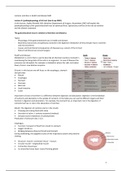Samenvatting
Summary all lectures nutrition in health and disease (master healthsciences)
- Instelling
- Vrije Universiteit Amsterdam (VU)
dit document bevat alle 10 de hoorcolleges van het vak nutrition in health and disease. Zowel de powerpoint als gesproken tekst van de docent is uitgewerkt, waardoor het document je een volledig overzicht geeft van de leerstof. this document contains all 10 lectures of the nutrition in health and...
[Meer zien]





